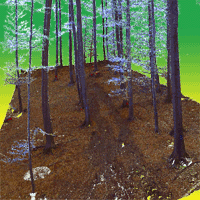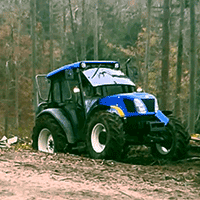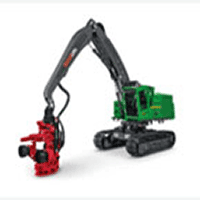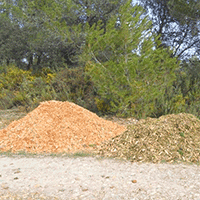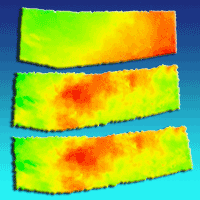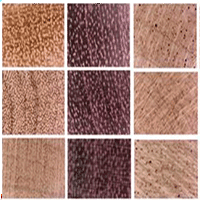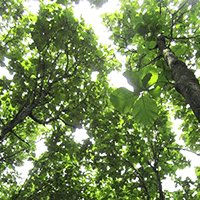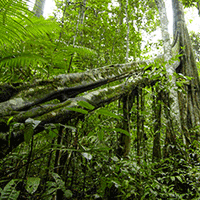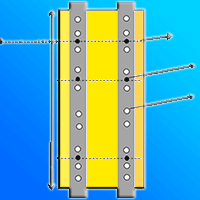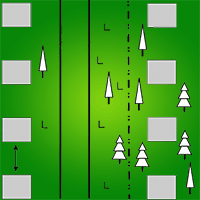
The natural recovery of disturbed soil, plant cover and trees after clear-cutting in the boreal forests, Russia
Aleksey Ilintsev (1-2) , Alexander Bogdanov (1-2), Elena Nakvasina (2), Irina Amosova (3), Sergey Koptev (2), Sergey Tretyakov (2)
iForest - Biogeosciences and Forestry, Volume 13, Issue 6, Pages 531-540 (2020)
doi: https://doi.org/10.3832/ifor3371-013
Published: Nov 18, 2020 - Copyright © 2020 SISEF
Research Articles
Abstract
This study aims to determine the impact of forest harvesting machinery on the temporarily moist soil of spruce forests (Picea abies Karst.) during the summer. For research purposes, we investigated 23 sites of the boreal forest in the European North of Russia (Arkhangelsk region) where logging operations had been carried out using harvesters and forwarders (CTL, cut-to-length harvesting). In the 15 years after logging, the sites were monitored for changes in physical soil properties and the depth/width of ruts and vegetation. In freshly cut areas, the depth of the ruts was linked to the amount of logging residue that had been used to strengthen skidding trails. After 15 years, the ruts were smooth but had not disappeared entirely. The average depth of the ruts decreased from 36 cm to 18 cm during the period under review. At a depth of 0-10 cm, the soil bulk density of the section between the control area and the wheel track increased by 19-27% within the first two years. At a depth of 10-20 cm, the soil bulk density only increased by 16-17% within the two-year period. After 15 years, the soil bulk density had decreased to the extent that there were no signs of heavy machinery movement. The natural restoration of vegetation in the ruts was affected by the presence of stagnant water in the initial post-logging period. Ruderal species and species with broad ecological amplitude to environmental factors grew over the skid trails. 15 years after logging, this overgrowth had stabilised, with the biodiversity level in the control area approaching its pre-logging state. Primarily, the renewal of the cutting areas occurred through species such as birch (Betula pendula Roth.) and aspen (Populus tremula L.). The highest amount of undergrowth (more than 30.000 ha-1) was detected 6-8 years after logging. This then decreases in areas that were cut down earlier. There are environmental consequences of clear-cutting (using the CTL system) on temporarily moist soil. To prevent the formation of deep ruts, it is recommended to leave 15-20 kg m-2 of felling residue.
Keywords
Clear-cuttings, Soil Disturbance, Rutting, Vascular Species, Natural Tree Regeneration
Authors’ Info
Authors’ address
Alexander Bogdanov
Northern Research Institute of Forestry, Arkhangelsk 163062 (Russia)
Alexander Bogdanov
Elena Nakvasina 0000-0002-7360-3975
Sergey Koptev
Sergey Tretyakov
Department of Silviculture and Forest Management, Northern (Arctic) Federal University named after M.V. Lomonosov, Arkhangelsk 163002 (Russia)
Department of Biology, Ecology and Biotechnology, Northern (Arctic) Federal University named after M.V. Lomonosov, Arkhangelsk 163002 (Russia)
Corresponding author
Paper Info
Citation
Ilintsev A, Bogdanov A, Nakvasina E, Amosova I, Koptev S, Tretyakov S (2020). The natural recovery of disturbed soil, plant cover and trees after clear-cutting in the boreal forests, Russia. iForest 13: 531-540. - doi: 10.3832/ifor3371-013
Academic Editor
Rodolfo Picchio
Paper history
Received: Feb 10, 2020
Accepted: Sep 14, 2020
First online: Nov 18, 2020
Publication Date: Dec 31, 2020
Publication Time: 2.17 months
Copyright Information
© SISEF - The Italian Society of Silviculture and Forest Ecology 2020
Open Access
This article is distributed under the terms of the Creative Commons Attribution-Non Commercial 4.0 International (https://creativecommons.org/licenses/by-nc/4.0/), which permits unrestricted use, distribution, and reproduction in any medium, provided you give appropriate credit to the original author(s) and the source, provide a link to the Creative Commons license, and indicate if changes were made.
Web Metrics
Breakdown by View Type
Article Usage
Total Article Views: 39877
(from publication date up to now)
Breakdown by View Type
HTML Page Views: 33397
Abstract Page Views: 3171
PDF Downloads: 2640
Citation/Reference Downloads: 1
XML Downloads: 668
Web Metrics
Days since publication: 1853
Overall contacts: 39877
Avg. contacts per week: 150.64
Citation Metrics
Article Citations
Article citations are based on data periodically collected from the Clarivate Web of Science web site
(last update: Mar 2025)
Total number of cites (since 2020): 11
Average cites per year: 1.83
Publication Metrics
by Dimensions ©
Articles citing this article
List of the papers citing this article based on CrossRef Cited-by.
References
Dinamika napochvennogo pokrova severotaezhnogo el’nika chernichnogo v pervye gody posle rubki [Dynamics of ground cover in Piceetum myrtillosum in northern taiga during the first years after clear-cutting]. Botanicheskii Zhurnal 103 (3): 364-381. [in Russian with English summary]
CrossRef | Gscholar
Middle-term changes in topsoils properties on skidding trails and cutting strips after long-gradual cutting: a case study in the boreal forest of the North-East of Russia. Croatian Journal of Forest Engineering 39 (1): 71-83.
Online | Gscholar
Ekologo-biologicheskij analiz vliyaniya razlichnyh vidov rubok na strukturu travyano-kustarnichkovogo yarusa chernichnyh tipov lesa [The effect of different cuttings on the ecological-biological structure of the grass-shrub layer in the blueberry forest]. Forestry Engineering Journal 9 (1): 31-44. [in Russian with English Abstract]
CrossRef | Gscholar
Climate change 2013: the physical science basis. Contribution of Working Group I to the Fifth Assessment Report of the Intergovernmental Panel on Climate Change (Stocker TF, Qin D, Plattner G-K, Tignor M, Allen SK, Boschung J, Nauels A, Xia Y, Bex V and Midgley PM eds). Cambridge University Press, Cambridge, United Kingdom and New York, NY, USA, pp. 1535.
Online | Gscholar
World reference base for soil resources. International soil classification system for naming soils and creating legends for soil maps. World Soil Resources Reports no. 106, FAO, Rome, Italy, pp. 181.
Gscholar
Vliyanie forvarderov na lesnye pochvo-grunty [Impact of wood forwarding on forest soils]. Trudy Lesoinzhenernogo Fakul’teta PETRGU 9: 73-81. [in Russian with English summary]
Gscholar
Ecological methodology (2nd edn). Addison-Wesley Longman, Menlo Park, CA, USA, pp. 620.
Gscholar
Lesorastitel’noe rajonirovanie SSSR [Forest growth zoning of the USSR]. Science, Moscow, Russia, pp. 203. [in Russian]
Gscholar
Lesovodstvo: uchebnik dlja vuzov [Silviculture: textbook for universities]. MSFU Publ., Moscow, Russia, pp. 302. [in Russian]
Gscholar
K istorii formirovaniya sovremennyh tipov melkolistvennyh lesov severo-zapada evropejskoj chasti SSSR [On the history of the formation of modern types of small-leaved forests in the North-West of the European part of the USSR]. Botanicheskii Zhurnal 54 (1): 3-13. [in Russian with English summary]
Gscholar
Ob izuchenii ekologicheskoj struktury rastitel’nogo pokrova [On the study of the ecological structure of vegetation cover]. Botanicheskii Zhurnal 54 (7): 1002-1013. [in Russian with English summary]
Gscholar
Vodoohrannaja i pochvozashhitnaja rol’ lesov: vtoroe izdanie [Water and soil protection role of forests: 2nd edition]. ALL-Russian Research Institute for Silviculture and Mechanization of Forestry, Pushkino, Russia, pp. 208. [in Russian]
Gscholar

